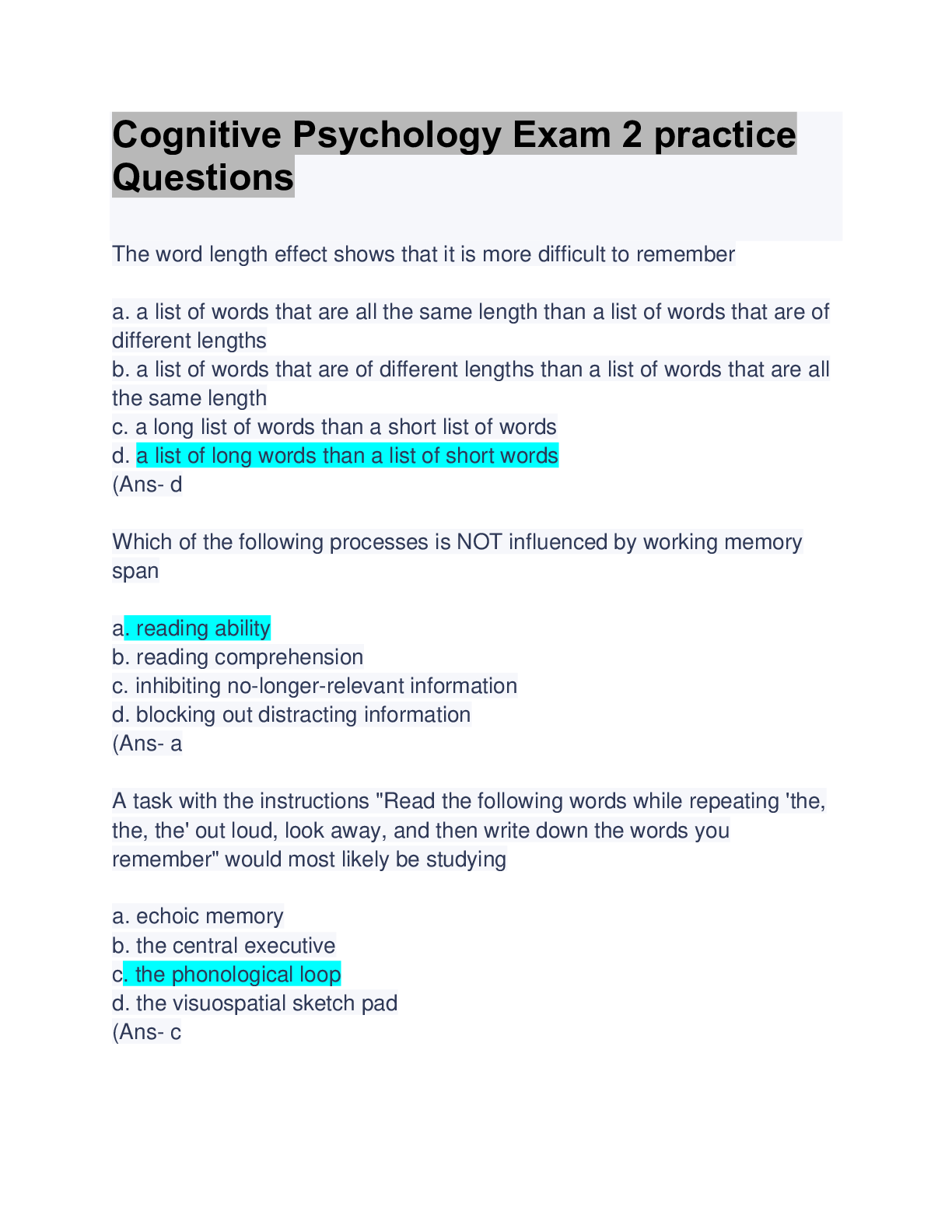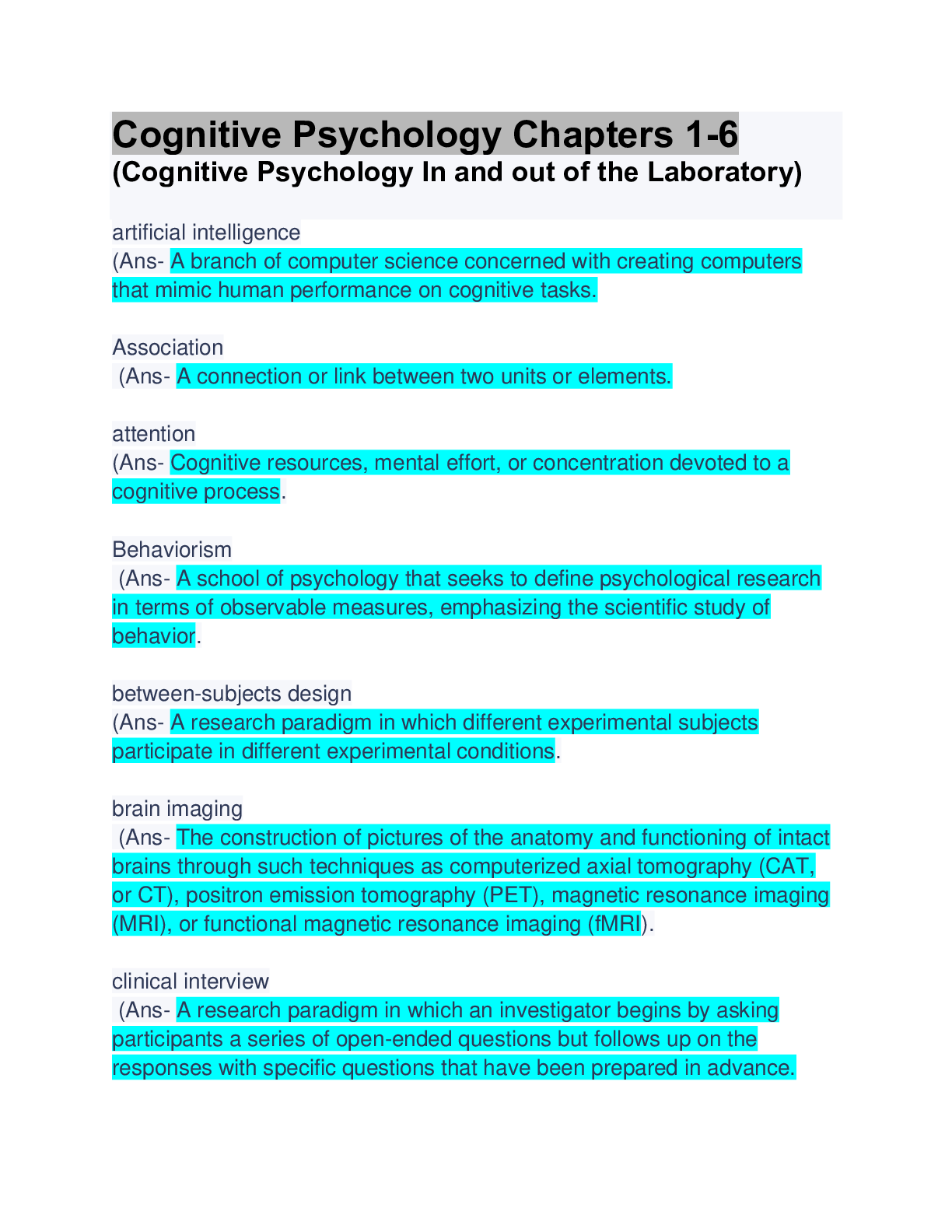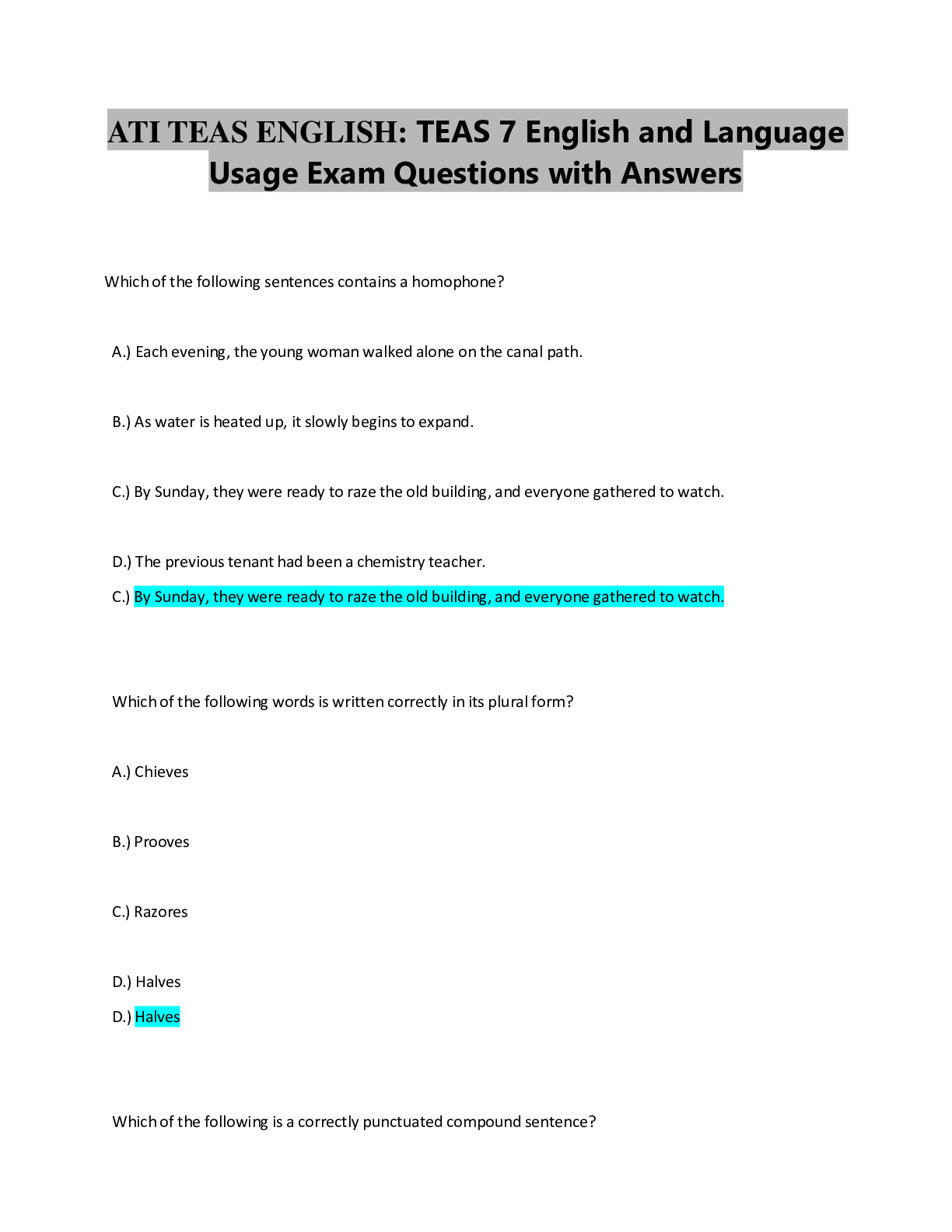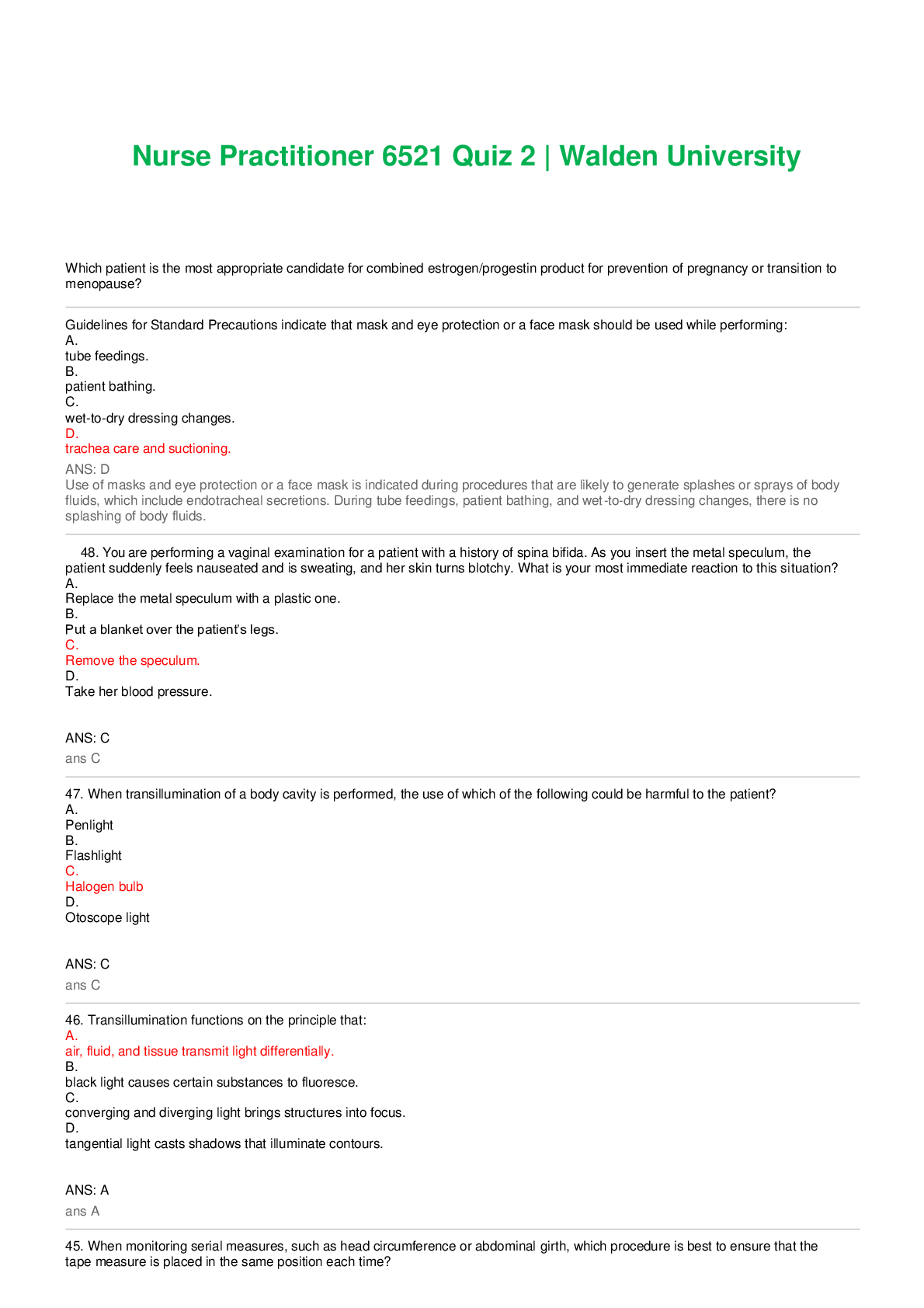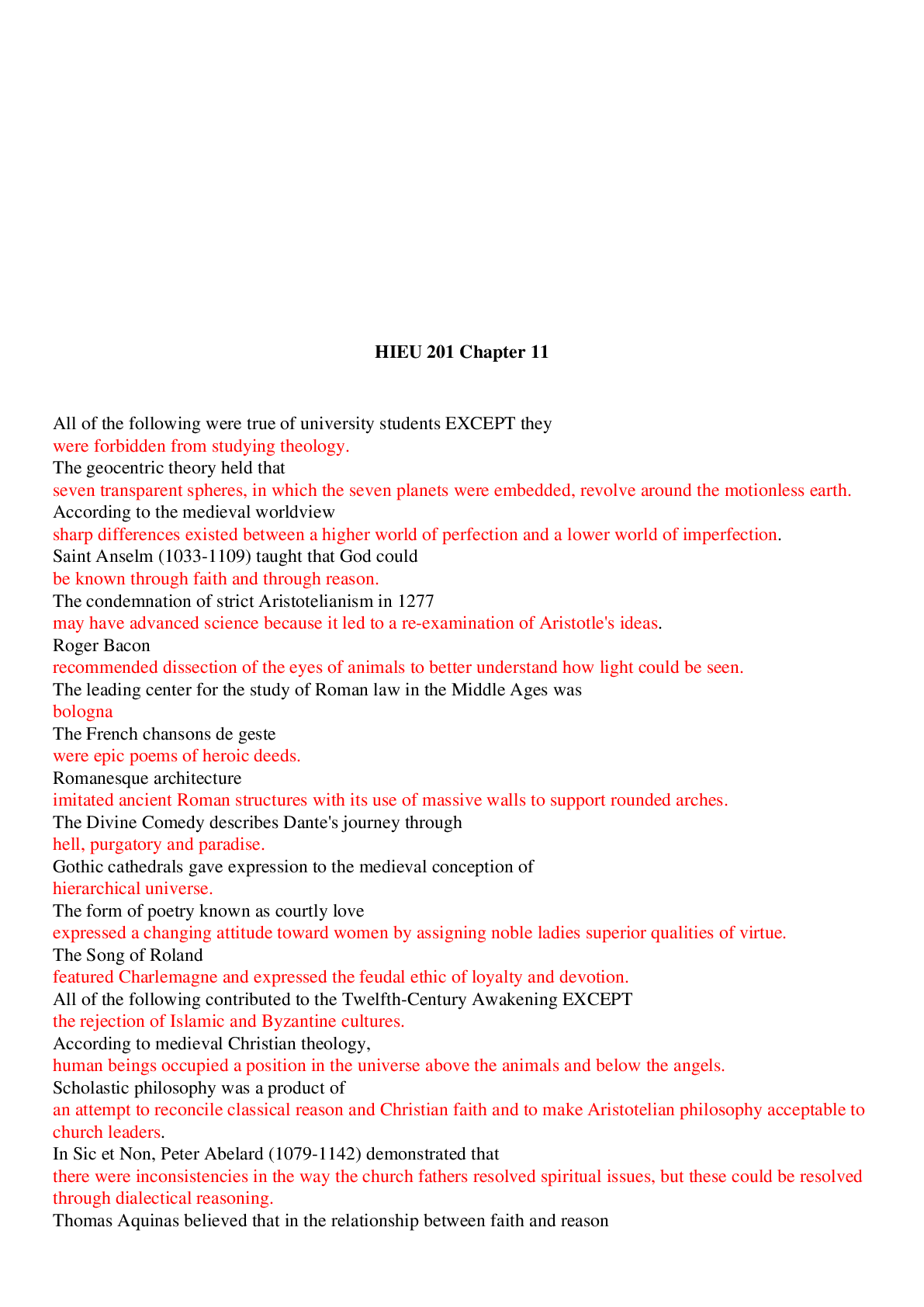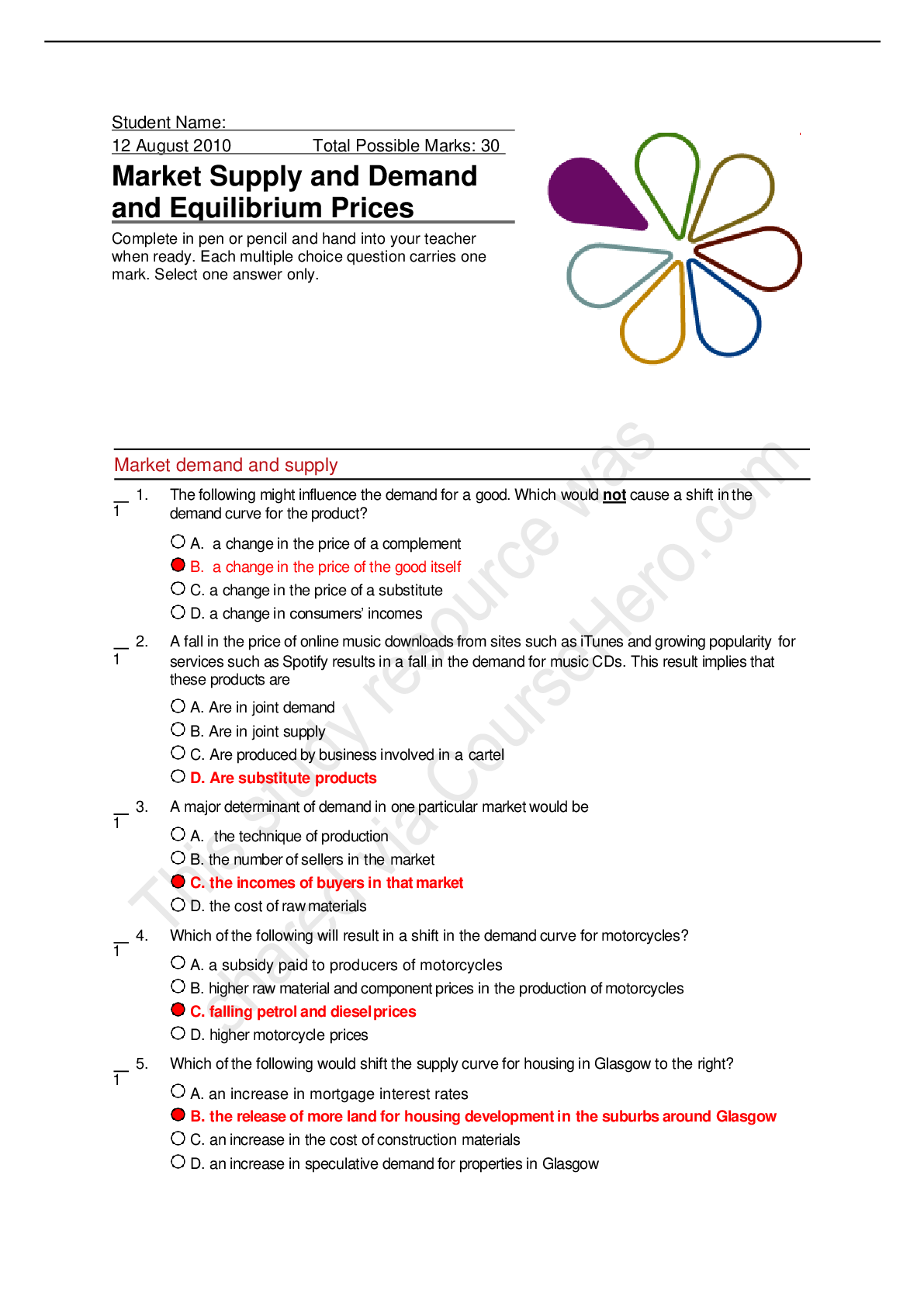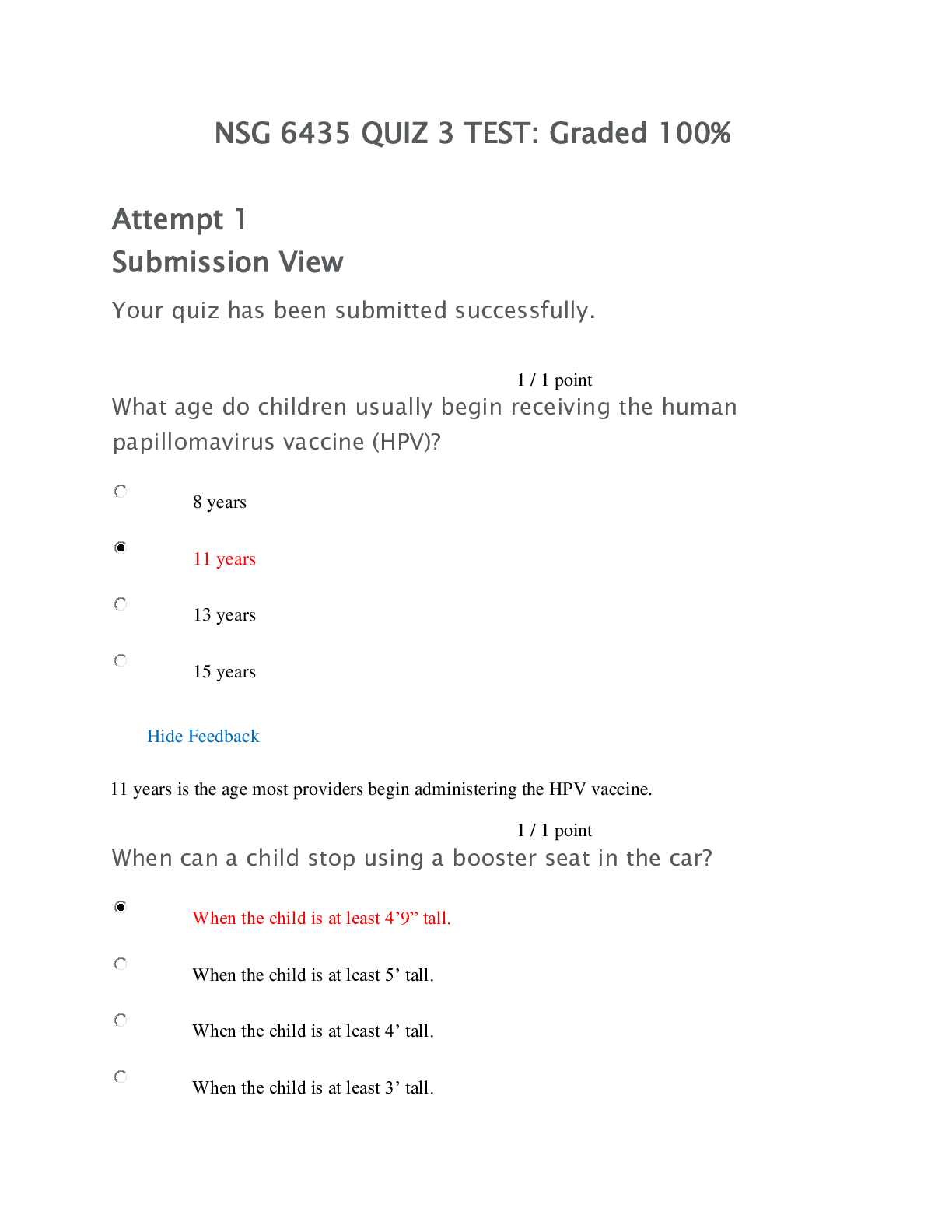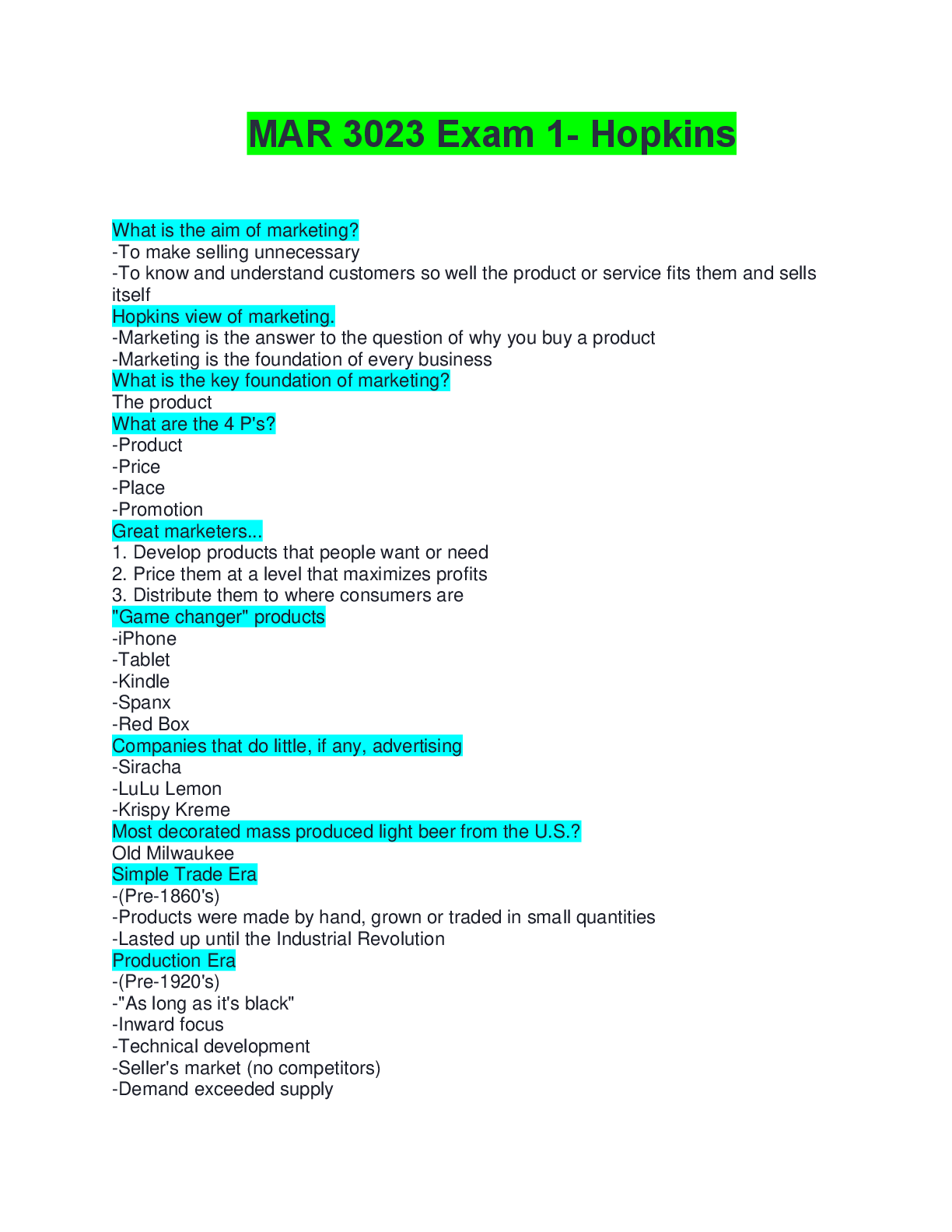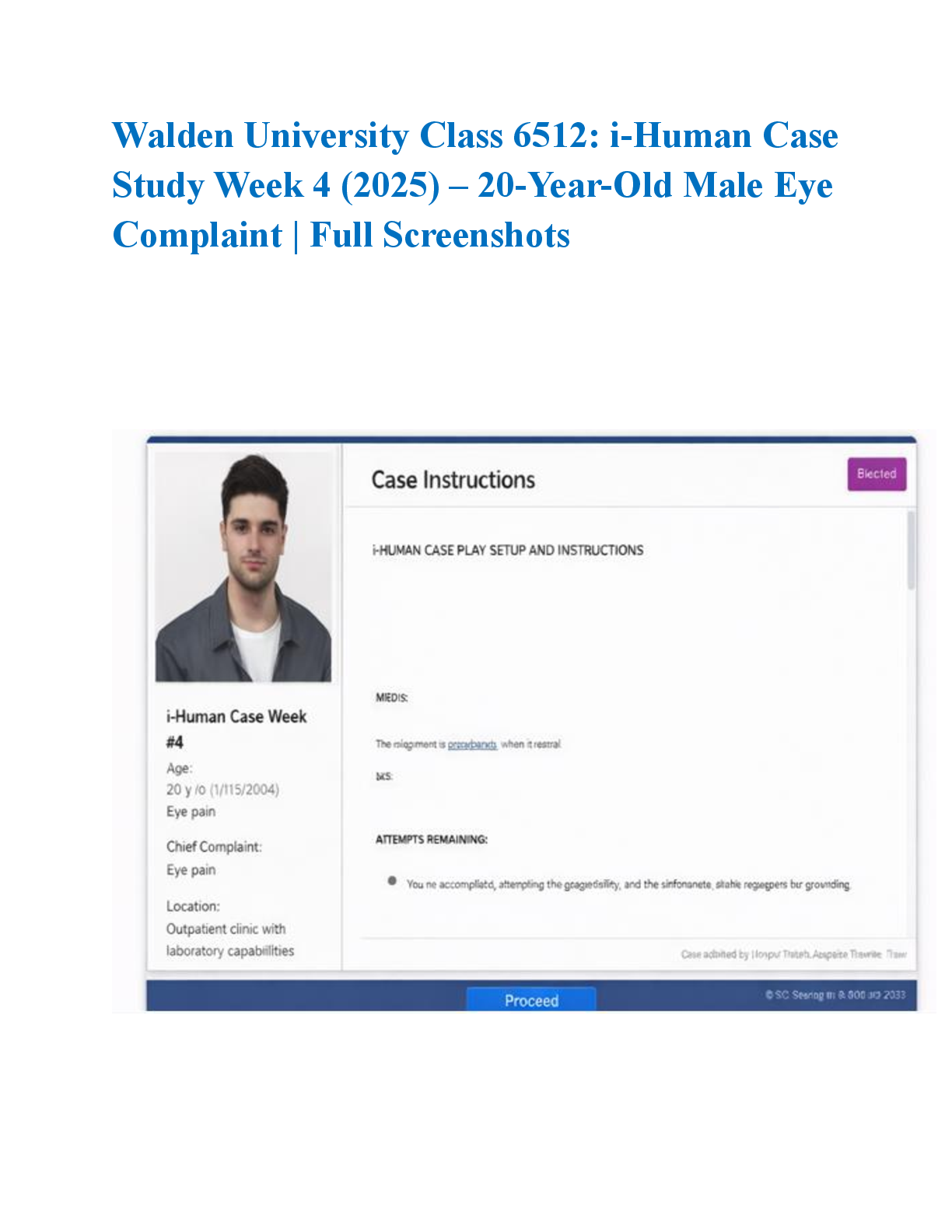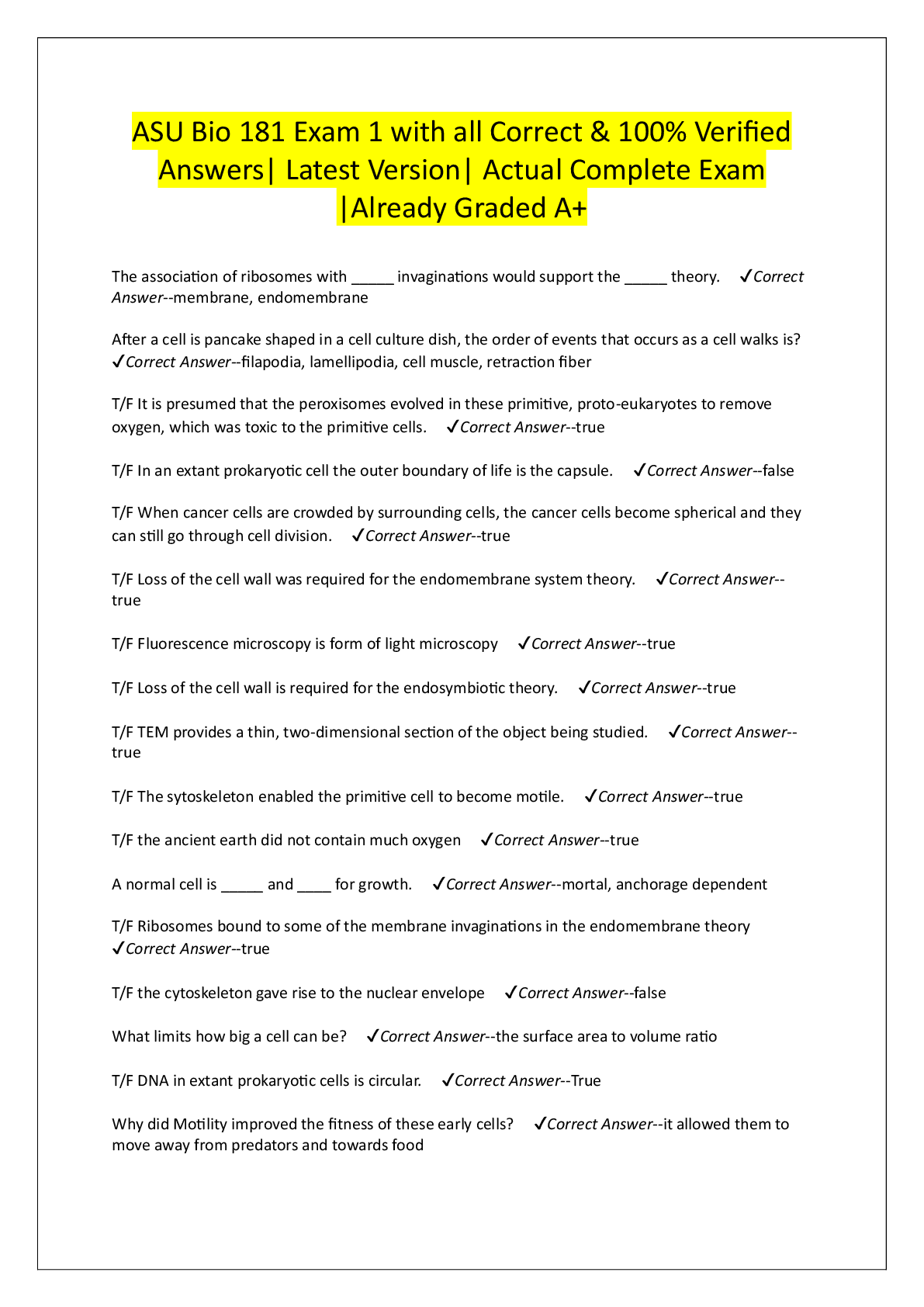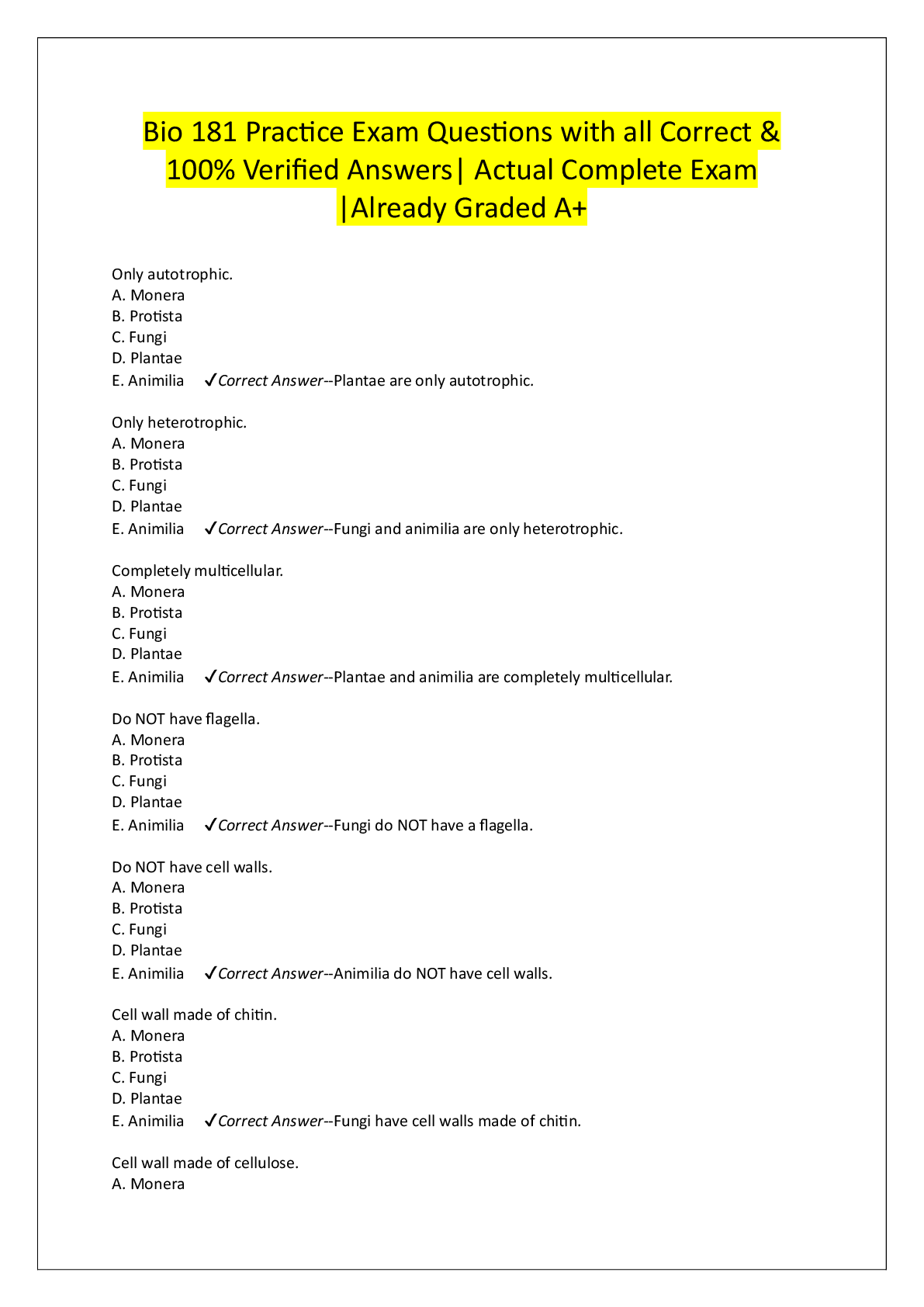Health Care > EXAM > OB Questions & Answers : 100% Verified Questions & Answers: Guaranteed A+ (All)
OB Questions & Answers : 100% Verified Questions & Answers: Guaranteed A+
Document Content and Description Below
1. True labor can be differentiated from prodromal or false labor in that in true labor there is a A. STRENGTHENING OF UTERINE CONTRACTIONS WITH WALKING B. Failure of presenting part to descend C. ... Lack of cervical dilation D. Cessation of uterine contractions with walking 2. Which of the following statement best describe the characteristic of true contraction? A. True contractions begin in the lower abdomen B. True contractions are difficult to determine because they come and go C. TRUE CONTRACTIONS HAVE A REGULARITY AND BECOME MORE INTENSE OVER TIME D. True contractions decrease with activity 3. The nurse is assessing between false and true labor. What does she ask the patient to do? A. Bear down B. WALK AROUND C. Time the contractions D. Do breathing exercise 4. The birth hazard unassociated with breech delivery is: A. Intracranial hemorrhage B. CEPHALHEMATOMA C. Compression of the cord D. Separation of placenta prior to delivery of the head 5. Assessment findings indicate that patient is 3 cm dilated, and contractions every 6 minutes lasting 40 seconds. The nurse should monitor the FHT A. Every 15 minutes B. Every 30 minutes C. EVERY 60 MINUTES D. Every 90 minutes 6. When a patient is admitted to the unit in active labor. What is the initial action the nurse should take?A. Assess for ruptured membranes B. TAKE V/S AND CHECK FHT C. Perform the Leopold’s maneuvers D. Catheterize for urine specimen 7. Which of the following statement best describe a normal female pelvis A. SACRUM WELL HOLLOWED, COCCYX MOVABLE, SPINES NOT PROMINENT, WIDE PUBIC ARCH B. Flat sacrum, movable coccyx, prominent spines, wide pubic arch C. Sacrum deeply hollowed, immovable coccyx, narrow pubic arch, spines not prominent D. Flat sacrum, movable coccyx, prominent spines, wide pubic arch 8. The most effective method of determining if the pelvis is adequate to allow the passage of the fetus vaginally is: A. Pelvimetry B. X-RAY EXAMINATION C. Assessment of characteristics of contractions D. Duration of labor 9. What does it mean during labor when the nurse assesses the fetal presenting part at “plus one”?A. One inch above ischial spines B. One inch below ischial spines C. ONE CM ABOVE ISCHIAL SPINES D. One cm below ischial spine 10.The nurse should be aware that which of the following variations in FHT may be considered normal A. Decrease in rate during the second stage of labor B. DECREASE IN RATE DURING THE MIDPORTION OF CONTRACTION C. Increase in rate following the rupture of membranes D. Increase in rate when engagement begins 11. The nursing assessment of a woman in labor reveals contractions lasting 60 seconds and 4 minutes apart; cervix is 6 cm and dilated. The woman is in what phase of the first stage of labor? A. Latent phase B. ACTIVE PHASE C. Transition phase D. Early phase I 12. Nursing assessment reveals active labor, breech presentation, ruptured membranes and passage of meconium stained amniotic fluid. The nurse valuates this as: A. A fetus in distress B. A NORMAL ASSESSMENT C. A sign of labor is progressing D. Indicative of CS 13. The bag of water is ruptured artificially when the fetal head is engaged in order to A. Enable the bag of water to rupture spontaneously if possible, thus avoiding difficult and painful instrumentation B. Prevent prolapse of the umbilical cord during the forceful expulsion of amniotic fluid from the sac C. Ensure that small amount of amniotic fluid would be left in the upper portion of the amniotic sac D. Have the amniotic sac in a dependent position that could be reached without difficulty 14. The cervix is considered completely dilated when the diameter of the os is: A. 6 cm B. 8 cm C. 10 CM D. 12 cm 15. In timing the contraction the nurse should notify the physician if she detects a contraction lasting longer thanA. 30 seconds B. 60 SECONDS C. 90 seconds D. 120 seconds 16. The mechanics of the second stage of labor differ from the first stage in that during the second stage A. The lower uterine segment contracts more than the fundus B. THE ABDOMINAL MUSCLES ASSIST IN THE EXPULSION OF THE FETUS C. The joint of the pelvis are stretched and dislocated D. All muscles involved in fetal propulsion undergo Tetany 17. The fetal head is engaged when A. The vertex of the skull is level with the symphysis pubis B. THE BIPARIETAL DIAMETER HAS PASSED THE PELVIC INLET C. The head rotates from the transverse to the AP position D. The head has descended beyond the external os 18. To determine the fetal position during labor the nurse should assess which of the following A. First body part of the fetus felt by the nurse upon vaginal examination B. RELATIONSHIP OF A FIXED POINT OF THE FETUS TO THE QUADRANTS OF THE MATERNAL PELVIS C. Relationship of the furthermost fetal part to the ischial spines of the maternal pelvis D. Relationship of the long axis to the mother’s body 19. During the early second stage of labor FHT should be taken at least every A. 2-4 minutes B. 5 to 10 minutes C. 10 TO 20 MINUTES D. 20 to 30 minutes 20. The changes in shape of the infant’s head that occur owing to pressure from the walls of birth canal are called A. MOLDING B. Cephalhematoma C. Microcephaly D. Caput succedaneum [Show More]
Last updated: 3 years ago
Preview 1 out of 17 pages
Buy this document to get the full access instantly
Instant Download Access after purchase
Buy NowInstant download
We Accept:

Reviews( 0 )
$9.00
Can't find what you want? Try our AI powered Search
Document information
Connected school, study & course
About the document
Uploaded On
Nov 10, 2022
Number of pages
17
Written in
All
Additional information
This document has been written for:
Uploaded
Nov 10, 2022
Downloads
0
Views
88


